
The Peruvian Aprista Party is a Peruvian social-democratic political party and a member of the Socialist International. The party was founded as the American Popular Revolutionary Alliance by Víctor Raúl Haya de la Torre, who originally intended to create a network of anti-imperialist social and political movements in Latin America. Members are called "compañeros" (fellows), based on the fraternity espoused by Haya de la Torre. Originally a centre-left to left-wing party with democratic socialist and nationalist elements, the party moved closer to the political centre under the leadership of Alan García starting in the 1980s, embracing social democracy and later some Third Way policies. In 2006, the party adopted a new platform as García's second presidency implemented a series of policies labelled as centre-right, embracing free-market capitalism, dialogue with other right-wing parties and organizations in the country, and closer ties with the Catholic Church and Evangelical churches.

Cambio 90 was a Peruvian right-wing political party which entered the political spectrum in early 1990, and throughout the 1990s until late-2000 was the most powerful political party in Peru alongside New Majority, serving more as an instrumental electoral vehicle for Alberto Fujimori.

Alberto Kenya Fujimori Inomoto was a Peruvian politician, professor, and engineer who served as the 54th president of Peru from 1990 to 2000. Of Japanese descent, Fujimori was an agronomist and university rector before entering politics. Generally recognized as a civilian-military dictatorship, his government was characterized by its use of propaganda, widespread political corruption, and human rights violations.

Alan Gabriel Ludwig García Pérez was a Peruvian politician who served as President of Peru for two non-consecutive terms from 1985 to 1990 and from 2006 to 2011. He was the second leader of the Peruvian Aprista Party and to date the only party member ever to have served as President. Mentored by the founder of the APRA, Víctor Raúl Haya de la Torre, he served in the Constituent Assembly of 1978–1979. Elected to the Peruvian Congress in 1980, he rose to the position of General Secretary of the APRA in 1982, and was subsequently elected to the presidency in 1985 in a landslide victory at the age of 35 years.
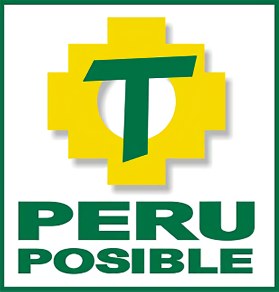
Possible Peru was a Peruvian political party. It was founded in 1994 by Alejandro Toledo with the original name of Possible Country.
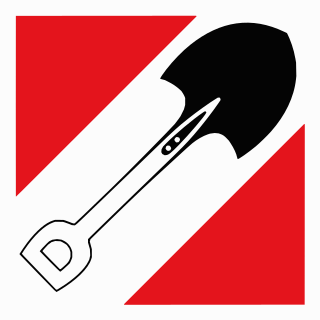
The Popular Action is a liberal and reformist political party in Peru, founded by former Peruvian president Fernando Belaúnde.

Valentín Toribio Demetrio Agustin Paniagua Corazao was a Peruvian lawyer and politician who briefly served as 55th President of Peru from 2000 to 2001. Elected President of Congress on 16 November 2000, he ascended to the presidency as incumbent Alberto Fujimori and both his Vice Presidents resigned by 22 November 2000.
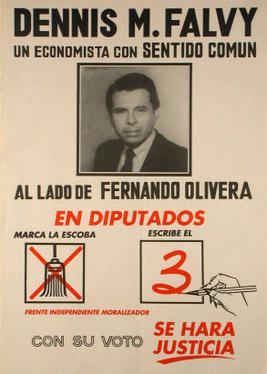
The Independent Moralizing Front was a Peruvian political party. At the legislative elections, 8 April 2001, the party won 11.0% of the popular vote and 11 out of 120 seats in the Congress of the Republic. Its presidential candidate at the elections of the same day, Luis Fernando Olivera Vega, won 9.9% of the vote. It was allied with former Peruvian president Alejandro Toledo's party, Peru Possible.

The Christian People's Party is a centre-right and conservative political party based on the principles of Christian democracy. It was founded in 1966 by Christian Democratic Party dissidents, led by Luis Bedoya Reyes, at the time mayor of Lima.

Lourdes Celmira Rosario Flores Nano is a Peruvian lawyer and politician who served as a councilwoman of Lima, Deputy from Lima from 1990 to 1992, Democratic Constituent Congresswoman from 1992 to 1995, Congresswoman from 1995 to 2000, and the Christian People's Party candidate for President of Peru in the 2001 and 2006 elections in which she ran under the National Unity.
Luis Fernando Olivera Vega is a Peruvian politician and leader of Independent Moralizing Front (FIM), a Peruvian political party.
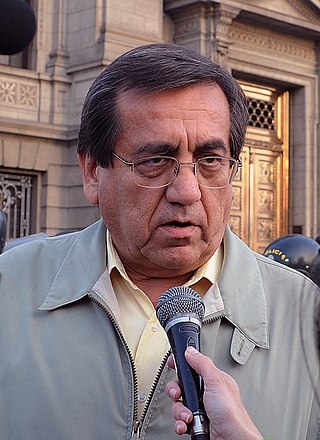
Jorge Alfonso Alejandro del Castillo Gálvez is a Peruvian lawyer and politician. In his career, he has served in the now abolished Peruvian Chamber of Deputies between 1990 and 1992, in the unicameral Congress of the Republic for six non-consecutive terms, between 1995 and 2011 and again from 2016 to 2019, five of which are consecutive terms, and as Mayor of Lima and the District of Barranco during the 1980s.

National Solidarity Party, was a conservative Peruvian political party. Founded in 1998 for the 2000 general election to support the candidacy of Luis Castañeda Lossio, a former Lima City Council member from Popular Action. Following the end of Alberto Fujimori's regime, the party formed the National Unity coalition with the Christian People's Party and other minor parties. Led by Lourdes Flores, the coalition placed third at the 2001 and 2006 general elections, while at municipal level, it won the capital city of Lima with Castañeda as the mayoral nominee.

Javier Maximiliano Alfredo Hipólito Valle Riestra González Olaechea or simply known as Javier Valle Riestra, was a Peruvian lawyer and politician. Known as a member of the Peruvian Aprista Party, he held several public offices, the most controversial among them being the President of the Council of Ministers during the presidency of Alberto Fujimori in 1998. This premiership is known for being the only one led by a politician from the opposition in Peruvian history during the Fujimori regime to date.

Carlos Ricardo Bruce Montes de Oca is a Peruvian politician and a former Congressman, representing Lima from 2006 until 2019, when his term ended with the dissolution of the Congress by Martín Vizcarra in 2019.

Luis Fernando Galarreta Velarde is a Peruvian Fujimorist politician and a former Congressman representing Lima between 2006 and 2020. He was President of the Congress for the 2017–2018 annual term. Galarreta was part of the presidential ticket of Keiko Fujimori in the 2021 elections that lost the elections to the Pedro Castillo ticket, however, he was elected to the Andean Parliament.

General elections were held in Peru on 10 April 2016 to determine the president, vice-presidents, composition of the Congress of the Republic of Peru and the Peruvian representatives of the Andean Parliament.
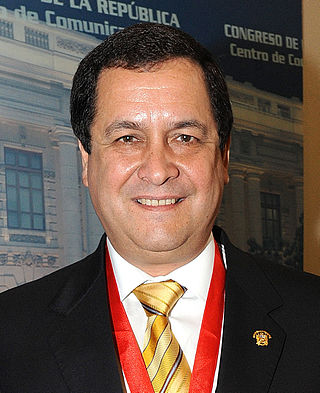
Luis Carlos Antonio Iberico Núnez is an Argentine-born Peruvian journalist and politician. Throughout his journalistic career, he served in various news stations during the 1980s and 1990s. He gained prominence for his fight against the Alberto Fujimori administration, denouncing several allegations of corruption involving the press. Alongside Fernando Olivera, he presented the first "Vladi-videos" that would prove the major corruption operations headed by Intelligence Chief Vladimiro Montesinos. His role in Fujimori's downfall would gain him support in a career in politics.
Su nombre es Fujimori is a documentary film directed by Peruvian Fernando Vílchez that shows a retrospective criticism of Fujimorato. It was part of the campaign for Anti-Fujimorism during the 2016 Peruvian general election.

The Banco Comercial was a multi-purpose office building located in the historic centre of Lima, Peru. It housed the Banco Comercial del Perú (BANCOPER), after which it was named, and later the Banco de la Nación. The building was designed by Peruvian architect Enrique Seoane Ros, and built by Flores & Costa, S.A., a Peruvian construction firm.



















